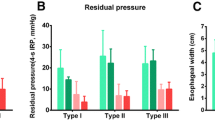Abstract
Background
Peroral endoscopic myotomy (POEM) is a novel, minimally invasive treatment for esophageal achalasia. We retrospectively examined and evaluated the results following POEM to verify the technique’s efficacy and safety.
Methods
We retrospectively analyzed data for patients who underwent POEM at eight Japanese facilities between September 2008 and October 2015. Pre- and postoperative assessments 3 months and 1 year after POEM included patient interviews, endoscopy, and manometry.
Results
A total of 1346 patients underwent POEM during the study period. Achalasia was the straight type in 1105 patients (82%) and the sigmoid type in 241 patients (18%). The average patient age was 47.2 years (range 3–95 years); 617 patients (46%) were men and 729 (54%) were women. Previous treatment included balloon dilatation in 381 patients (28%) and Heller–Dor operation in 43 patients (3%). The average operation time was 99.6 min. The mean length of the myotomy in the esophageal body was 10.8 cm, and the myotomy extended into the stomach a mean of 2.8 cm. The response rate (Eckardt score ≤ 3) was 95.1% 3 months postoperatively and 94.7% 1 year postoperatively. We noted 50 adverse events (3.7%) of Clavien–Dindo classification grade ≤ IIIa, and all resolved with conservative treatment. There were no Clavien–Dindo classification grade ≥ IIIb adverse events. After POEM, erosive esophagitis according to the Los Angeles classification was absent in 37% of the patients, grade A in 33%, B in 24%, C in 6%, and D in 0.2%. Symptomatic gastroesophageal reflux disease after POEM was confirmed in 14.8% of the patients; both erosive esophagitis and symptomatic gastroesophageal reflux disease responded to treatment with a proton-pump inhibitor.
Conclusion
Our results confirmed the safety and efficacy of POEM in a large patient series and support POEM as the first-line and standard treatment for esophageal achalasia.

Similar content being viewed by others
Abbreviations
- POEM:
-
Peroral endoscopic myotomy
- LES:
-
Lower esophageal sphincter
- GERD:
-
Gastroesophageal reflux disease
References
Richter JE (2001) Oesophageal motility disorders. Lancet 358:823–828
Japan Esophageal S (2017) Descriptive rules for achalasia of the esophagus, June 2012: 4th edn. Esophagus 14:275–289
Vaezi MF, Pandolfino JE, Vela MF (2013) ACG clinical guideline: diagnosis and management of achalasia. Am J Gastroenterol 108:1238–1249 (Quiz 1250)
Inoue H, Minami H, Kobayashi Y et al (2010) Peroral endoscopic myotomy (POEM) for esophageal achalasia. Endoscopy 42:265–271
Haito-Chavez Y, Inoue H, Beard KW et al (2017) Comprehensive analysis of adverse events associated with per oral endoscopic myotomy in 1826 patients: an international multicenter study. Am J Gastroenterol 112:1267–1276
Eckardt VF (2001) Clinical presentations and complications of achalasia. Gastrointest Endosc Clin N Am 11(281–92):vi
Inoue H, Tianle KM, Ikeda H et al (2011) Peroral endoscopic myotomy for esophageal achalasia: technique, indication, and outcomes. Thorac Surg Clin 21:519–525
Inoue H, Shiwaku H, Iwakiri K et al (2018) Clinical practice guidelines for peroral endoscopic myotomy. Dig Endosc 30:563–579
American Society of Anesthesiologists (2014) ASA physical status classification system. https://www.asahq.org/standards-and-guidelines/asa-physical-status-classification-system
Armstrong D, Bennett JR, Blum AL et al (1996) The endoscopic assessment of esophagitis: a progress report on observer agreement. Gastroenterology 111:85–92
Minami H, Inoue H, Haji A et al (2015) Per-oral endoscopic myotomy: emerging indications and evolving techniques. Dig Endosc 27:175–181
Shiwaku H, Inoue H, Yamashita K et al (2016) Peroral endoscopic myotomy for esophageal achalasia: outcomes of the first over 100 patients with short-term follow-up. Surg Endosc 30:4817–4826
Sato H, Takahashi K, Mizuno KI et al (2018) A clinical study of peroral endoscopic myotomy reveals that impaired lower esophageal sphincter relaxation in achalasia is not only defined by high-resolution manometry. PLoS ONE 13:e0195423
Tanaka S, Toyonaga T, Kawara F et al (2017) Peroral endoscopic myotomy using FlushKnife BT: a single-center series. Endosc Int Open 5:E663–E669
Von Renteln D, Fuchs KH, Fockens P et al (2013) Peroral endoscopic myotomy for the treatment of achalasia: an international prospective multicenter study. Gastroenterology 145(309–11):e1–e3
Zak Y, Meireles OR, Rattner DW (2018) Laparoscopic toupet fundoplication for GERD after POEM. https://www.sages.org/meetings/annual-meeting/abstracts-archive/laparoscopic-toupet-fundoplication-for-gerd-after-poem/
Tyberg A, Choi A, Gaidhane M et al (2018) Transoral incisional fundoplication for reflux after peroral endoscopic myotomy: a crucial addition to our arsenal. Endosc Int Open 6:E549–E552
Acknowledgements
The authors would like to thank Dr. Toshihiro Ohmiya (Digestive Disease Center of Showa University Northern Yokohama Hospital and Department of Gastroenterological Surgery, Fukuoka University Faculty of Medicine), Dr. Masaki Ominami (Digestive Diseases Center, Showa University Koto-Toyosu Hospital and Department of Gastroenterology, Osaka City University Graduate School of Medicine), Dr. Shin Kono (Digestive Diseases Center, Showa University Koto-Toyosu Hospital and Department of Gastroenterology and Hepatology, Tokyo Medical University), and Dr. Masayuki Nishimoto (Digestive Diseases Center, Showa University Koto-Toyosu Hospital and Department of Gastroenterology, Wakayama Medical University) for their contribution to data acquisition of this study.
Author information
Authors and Affiliations
Corresponding author
Ethics declarations
Disclosures
The authors state that this manuscript is being submitted as an accompaniment to a podium presentation at SAGES 2018, held in Seattle, WA, USA. Dr Haruhiro Inoue reports grants from Olympus Co. and grants from Boston Scientific Co. outside the submitted work. Hironari Shiwaku, Manabu Onimaru, Hitomi Minami, Hiroki Sato, Chiaki Sato, ShinwaTanaka, Ryo Ogawa, and Norihiko Okushima have no conflicts of interest or financial ties to disclose.
Additional information
Publisher's Note
Springer Nature remains neutral with regard to jurisdictional claims in published maps and institutional affiliations.
Rights and permissions
About this article
Cite this article
Shiwaku, H., Inoue, H., Onimaru, M. et al. Multicenter collaborative retrospective evaluation of peroral endoscopic myotomy for esophageal achalasia: analysis of data from more than 1300 patients at eight facilities in Japan. Surg Endosc 34, 464–468 (2020). https://doi.org/10.1007/s00464-019-06833-8
Received:
Accepted:
Published:
Issue Date:
DOI: https://doi.org/10.1007/s00464-019-06833-8




